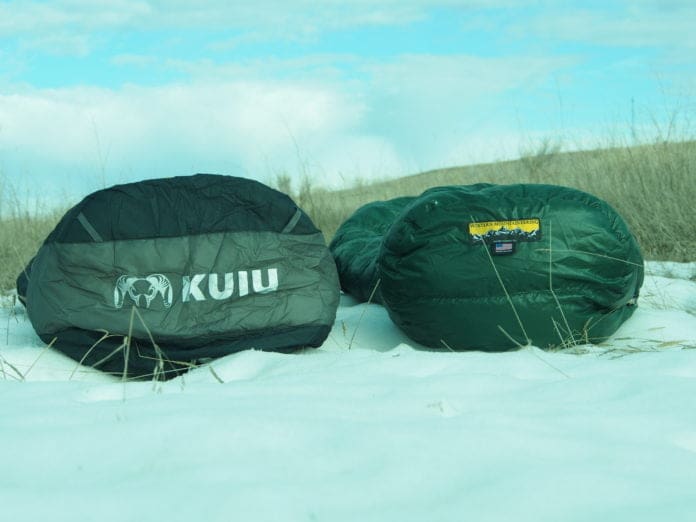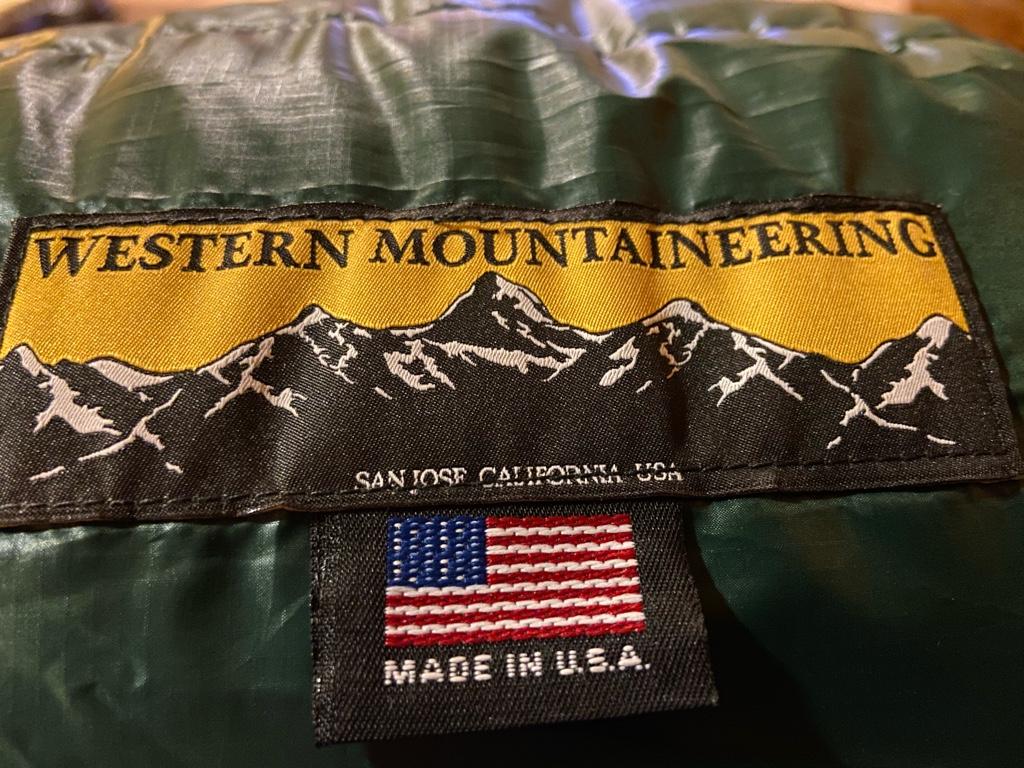 KUIU released their Super Down Sleeping Bags in 2014. The bag incorporated Quixdown®, a revolutionary treated down that is essentially waterproof. I still remember, while attending the WHCE that year, Patrick Mayer of KUIU dunking the Quixdown® into a cup of water. Compared to the adjacent cup filled with regular down, the Quixdown® maintained it’s loft while the regular down clumped into the bottom of the cup. I had to wonder how that demo would translate into real-world mountain use?
KUIU released their Super Down Sleeping Bags in 2014. The bag incorporated Quixdown®, a revolutionary treated down that is essentially waterproof. I still remember, while attending the WHCE that year, Patrick Mayer of KUIU dunking the Quixdown® into a cup of water. Compared to the adjacent cup filled with regular down, the Quixdown® maintained it’s loft while the regular down clumped into the bottom of the cup. I had to wonder how that demo would translate into real-world mountain use?
Five years later, with KUIU as a Rokslide sponsor, I had the chance to review the KUIU Super Down Sleeping bag (in regular, 15°, 6′). I could now answer my own question. I did some more reading on the bag to brush up on the features. Everything you need to know, except actual field performance, is at that link. The purpose of this review is to test the field performance as objectively as possible.
The Design
Of interest to me was the IDFL Certification on the temp rating. As of press time, the specs were not available to link for the 15° bag, but KUIU confirmed an EN tested Lower Temp Limit (T Limit) of 16° F. While I have no doubt on the numbers KUIU provided, I’ve also learned that individual users may or may not sleep well at those temperatures (read why here). That is why I like to test my own body’s comfort level before committing a sleeping bag to a hunt.
The KUIU Super Down includes a full hood and halo, and shoulder & zipper baffles to minimize heat loss. To the eye, it’s also a great looking bag with a taper from hood to footbox.
The design distributes the Quixdown® in vertical baffles from head-to-toe to better distribute heat. There are “integrated flow gates” in each baffle that keep the down from shifting and creating cold spots.
A Competitor Head-to-Head
When word got out that I’d be testing this bag, many of our Rokslide members asked if I could test the KUIU Super Down against the Western Mountaineering Badger MF (WMB), another top-tier bag. Ryan Avery owned one of those (also in medium 15°, 6′) so he sent it to me for comparison. You can see the features of that bag here.
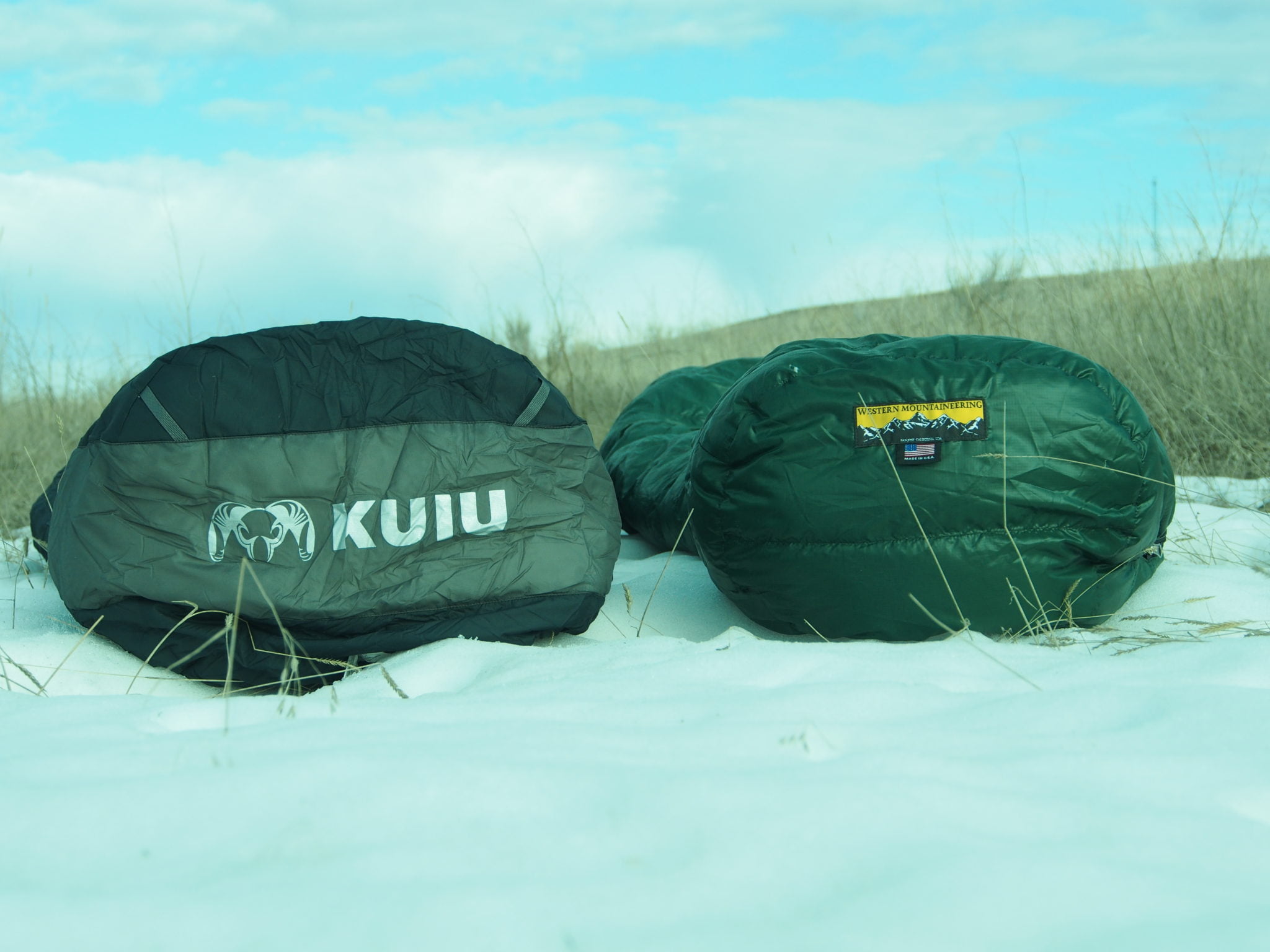
To note, the WMB uses a continuous horizontal baffle that surrounds the body. I learned from one Rokslide member, sndmn11, that this design allows the user to shift the down from the underside of the bag to the topside, adding insulation to where and when it’s needed. It’s also a hooded bag with a full down draft collar. The WMB is also a slighty bigger bag than the KUIU, all specs are here.
Testing Conditions
Hunting season was long gone by the time the KUIU Super Down hit my doorstep, so I’d have to do the test in my backyard in winter conditions. The conditions in late winter in my hometown of Iona, Idaho aren’t much different than the October storms in the high country of the West, and I’ve tested bags successfully at home before.
Your Tester
I’m 5’9″ and 179 lbs. I’d say I’m a very cold sleeper compared to other camp mates I’ve hunted with over the decades. For example, I used a 0° military down bag for years, while my hunting partner skated with a much lighter bag on many a sub-zero night. I’ve learned to sleep at least partially clothed and/or pull tarps over my bag on the coldest nights. With this in mind, I decided to do my testing in my standard sleeping clothes that I’d expect to wear when conditions would be near the 15° mark:
- Baselayer (First Lite Fuse & Furnace)
- Pant (First Lite Obsidian on the coldest nights)
- Jacket (First Lite Brooks)
- Light glove
- Wool Socks
- Light Beanie
I set up my two-man floored shelter under my Colorado Blue Spruce trees on February 2nd. The ground in my backyard was bare but frozen solid.
The Test Parameters:
I tested the two bags in the following areas:
- Lowest comfortable temperature (T Limit)
- Water Resistance
- Weight/Packed Size
- Features (hood, draft collar zipper, etc.)
For both bags, I used the EXPED Megamat Lite MW with an R-value of 5.3, rated to -4°, and a small down pillow.
KUIU Temperature Test
I put both bags in my tent but jumped in the KUIU Super Down the first night. My shortcoming was although I’d read about the KUIU, I hadn’t used it. I put my pillow on the inside of the bag (a no-no I later found out). This prevented me from completely zipping the hood over my face. I figured the neck baffle would stop any drafts/heat loss.
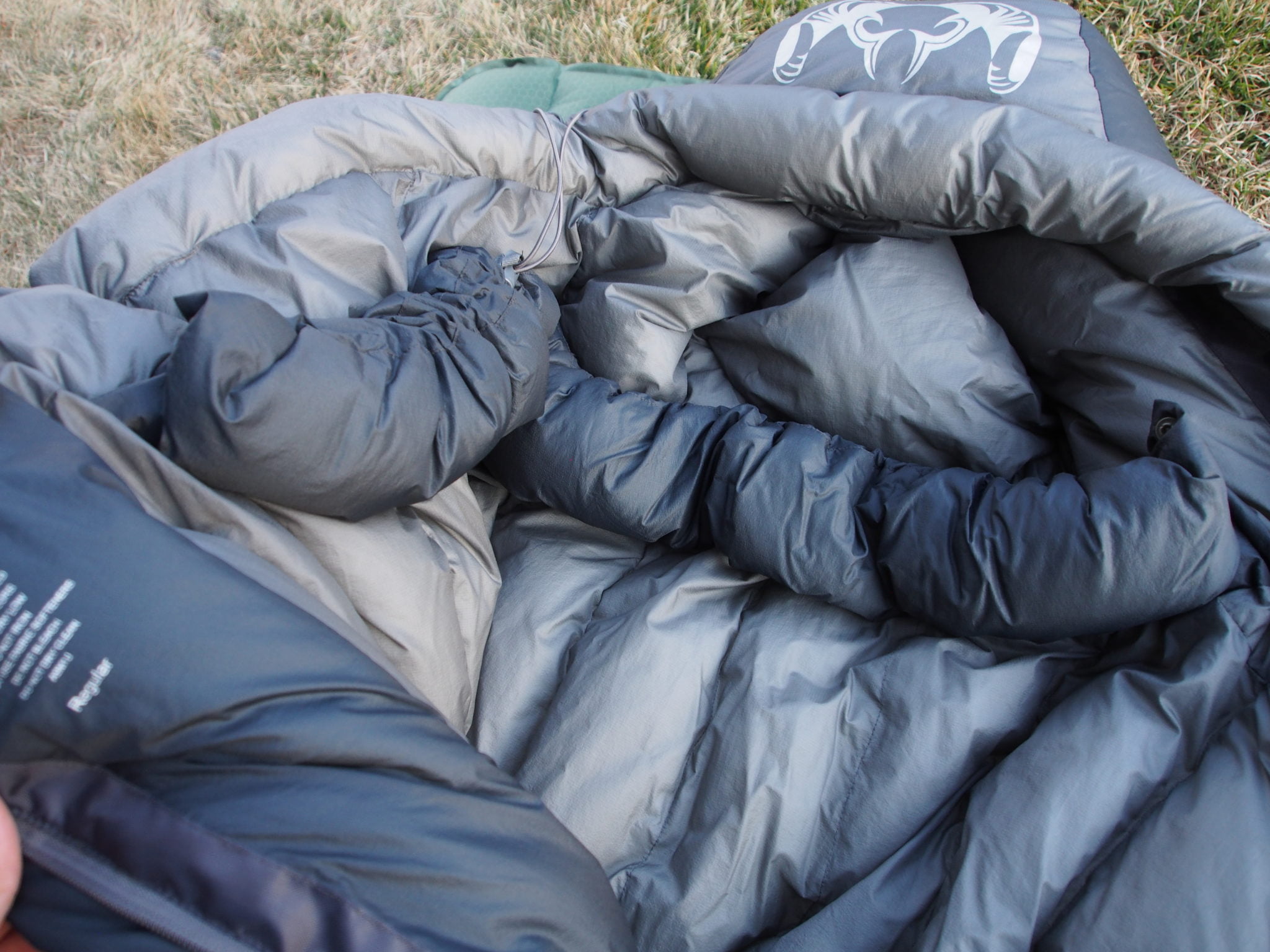
I was wrong and by 3:00 AM, at 19°, my thighs were cold, so I jumped into the WMB to see if I’d fare any better. I did not, so I headed in the house.
Chatting with a few Rokslide members, I decided the next night out, I’d be sure and close the bag completely, putting the pillow on the outside. I also pulled the inside drawstring tighter. I found that the hood on the KUIU is well designed, keeping the bag close to my face, but allowing me room to freely breathe.

Before heading out to the tent, I moved the down from the underside of the WMB bag to the topside (made possible by their continuous baffle system.) This was done easily enough by opening the bag, and shaking the insulation into the topside baffles.

A few days later, the forecast looked perfect, so I headed out and climbed in the KUIU.

I slept hard for most of night. The last hour, I felt a little chill set in, again on my thighs. I was sleeping on my back and the bag was touching my thighs. I rolled onto my side. This put a little dead airspace between my thighs and the bag. That was all it took to mostly get rid of the chill. I’m guessing that was in the last hour or so of sleep. Alarm went off at 6:30 and by golly, I made it to 16° degrees, the exact T Limit advertised by KUIU.

By understanding the proper use of a pillow, the draft collar, and drawstrings, I’d added another 3° to the bag, reaching the advertised T Limit.
The WMB Temperature Test
WMB has an interesting but transparent way of temp rating their bags (click here to read more). They list the WMB EN tested T Limit at 11°, but conservatively rate the bag at 15°.
To note, I’d received this bag just before my last hunt of 2019–a late November muzzleloader hunt. Temps were in the single digits and the first night I learned that was too cold for this bag. So I suspected already it would also land close to their published rating of 15°.
Just a week after the KUIU test, the overnight forecast was for 13°, close enough to give the WMB it’s turn.
I went to bed about 10:30 PM and slept well till about 5:00 AM when I started to get chilled. However it wasn’t just around my thighs like the other nights, but generally from my torso down. Not freezing, just a slight chill—enough to keep me from falling back to sleep. I rolled onto my side and fought it for a while, but I finally realized it wasn’t going to get any better. I pulled out my phone and checked the weather.

Exactly the same temperature I pushed the KUIU Super Down to, but I was cold in the WMB. My unscientific test put the KUIU Super Down ahead of the WMB by at least a few degrees.
The Soak Test
This is another unscientific test I’ve used to determine if a down bag can perform in the event of worse-case scenario: a wet bag.
I’ve heard some people tout that anyone with any common sense can keep a down bag from water exposure. I’m not sure how or where they hunt, but that’s awful bold talk that won’t do any good in the backcountry when a tent collapses or you tip a pan of water off the woodburner onto your bag or fall down with a full pack in the creek or the packraft takes on water, or, or, or….I at least want to know what to expect in the event of the unexpected.
If there’s rain, I simply set the bag out, or if it’s dry, a hose will do. For the KUIU v. the WMB, rain was in the forecast. I pulled the bags from the tent and laid them out in a steady drizzle. Under the foot boxes I placed two identical trays with 0.5″ of water to simulate puddles. I did the best I could to seal the top of the bag so no water could run in under the hoods, and I believe I was successful.
 Two-and-a-half hours later, with several puddles inches deep on each bag, I carefully tipped them so the water ran off, not into the hood openings. I pulled them in the tent and opened them up.
Two-and-a-half hours later, with several puddles inches deep on each bag, I carefully tipped them so the water ran off, not into the hood openings. I pulled them in the tent and opened them up.
The KUIU had a measurable amount of water droplets inside, amounting to a few teaspoons. I had to look hard to find them but they were there. Inspecting the down, there was no clumping and loft still appeared 100%, even at the footbox where exposure was the greatest. I shook the bag and expelled the droplets.
I then zipped open the WMB, where surprisingly, I found no water, anywhere. This bag also maintained it’s loft.
So the win to the WMB in this test.
Discussing the results with a few Rokslide members, we surmised that the little bit of water that got into the KUIU likely came through through a seam (had it come through the Toray shell, there should have been equal amounts of water thoughout the bag, but there was not.) My best guest is that the hydrophobic Quixdown® did it’s job of repelling the water so the few drops ended up in the bag and not in the down.
It seems the WMB MicroLite XP™ fabric shell, advertised as water resistant, was very effective at keeping the water from the untreated down. I think that is why this bag performed so well in this test.
Keep in mind, this is not a controlled scientific test, but it does show the modern designs of these bags can get you through a soaking without losing the insulating properties of the bags. If you’d like to see this soak test on video, click here
Packed Size/Weight
The KUIU Super Down in 15° tips the scale at 1lb 15 oz vs. 2lb 6 oz on the WMB at 15° , 7 oz less.
It’s also proportionally smaller in packed size as shown by the photo below.
This is a win for the KUIU considering it performed better at lower temps with no weight or bulk penalty
Features
I personally liked the fit of the KUIU hood better. I didn’t have to pull the drawstring as tight as the WMB to stay warm while still keeping bag off my mouth to minimize condensation.


The drawstring and draft collar were also easier to use on the KUIU, by a small margin.
The zipper of the WMB had less snags and was easier to zip, although KUIU had tags on their zipper making it easier to grasp (and they glow in the dark). If you go with the KUIU, my advice is to learn how to zip it shut/open with the tab in your thumb/index finger, and your middle finger lifting the baffle ahead of the zipper.
If you’re a bigger person than me, you might like the extra room around the head and shoulders provided by the WMB.
A Note on Durability
I’ve said this in all my reviews: it’s not realistic to comment on durability in most gear reviews of new product with just a few days’ use. Durability is usually determined after a few seasons, or even longer. So I’m forced to either guess, or rely on Rokslide members who’ve owned the product much longer than me. Luckily, I found just that…
Rokslide member Blockcaver chimed in on my semi-live review thread with his experiences. I’ll let him take it from here:
“I’ve had my KUIU 15° Super Down bag since they came out in 2014. I have over 200 nights in the bag to date. The graphics have started to wear off and it has some down bleed, but it is holding up well. It still maintains nearly 12″ loft in the footbox.”
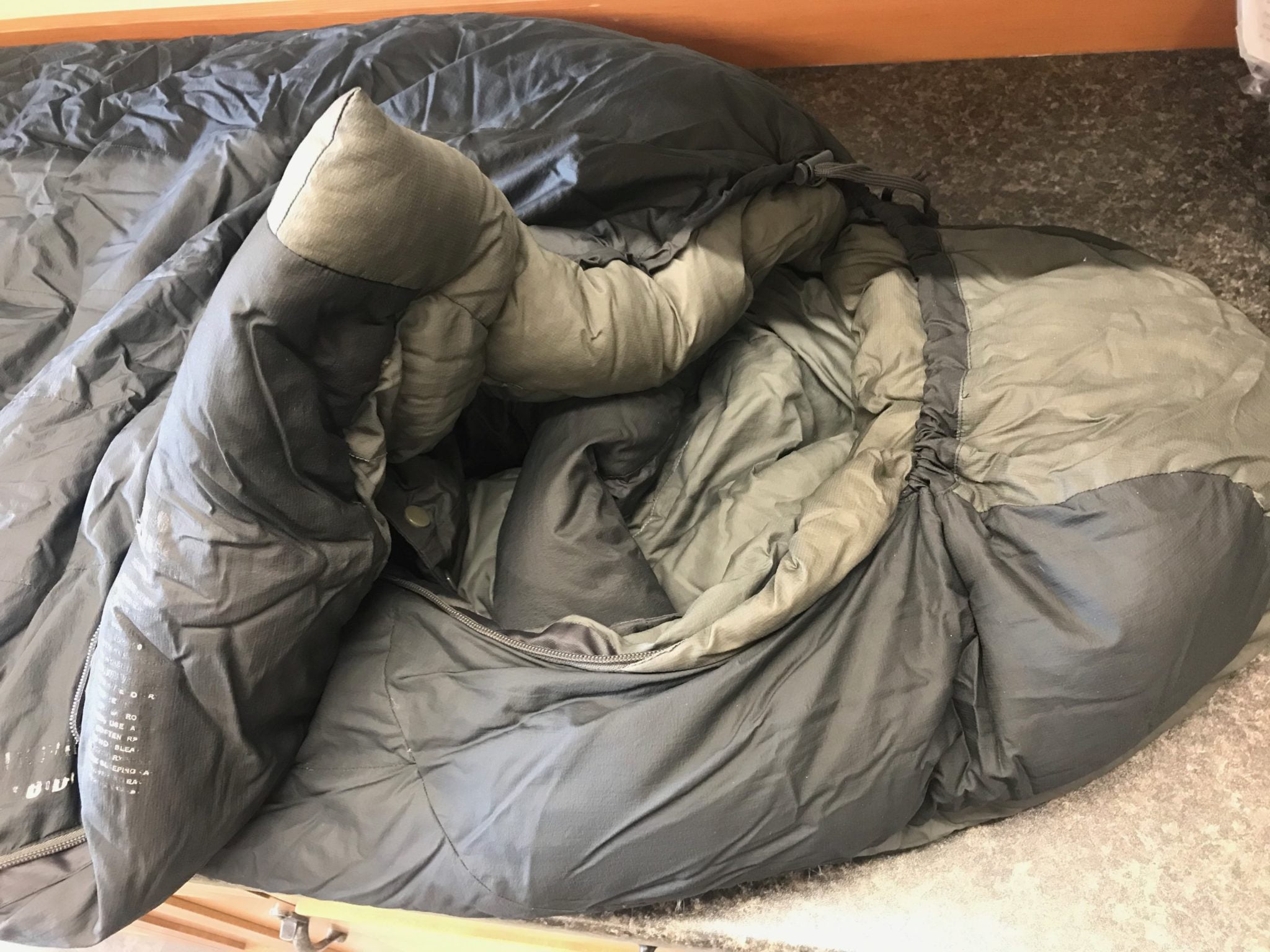
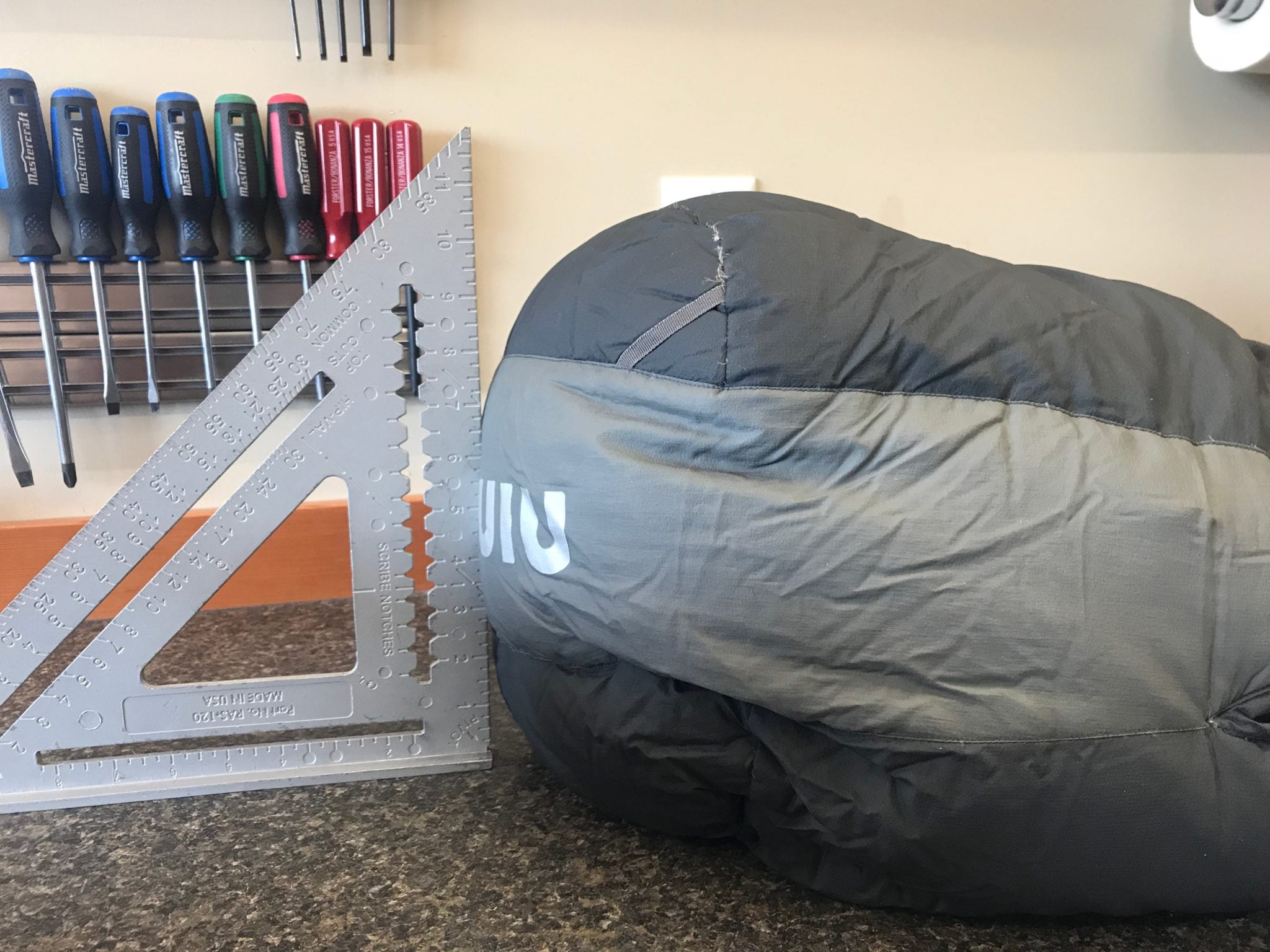
As of press time, I didn’t receive any feedback from WMB users, but with that company’s solid reputation, I’m sure that bag will wear just fine.
Final Thoughts
If you want to put the final tap on the brass tacks, here’s how the head-to-head landed:
Lowest Temperature (T limit): KUIU Super Down
Water Resistance: Western Mountaineering Badger
Packed Size/Weight: KUIU Super Down
Features: KUIU Super Down
Price: Both bags are in the $600 range Tie
Looks: If that even matters, I found the KUIU a better looking bag
While these are two high performance modern down bags that hunters should be really happy with, personally I’d take the KUIU Super Down.
*As of press time, KUIU has pulled their 15° bag from their website, only the 30° and the 0° are shown. You can purchase either here
Or if you go the Western Mountaineering route, Rokslide Sponsor Seek Outside has the Badger MF here
If you’d like to ask questions or read other Rokslide members’ experiences, click here















